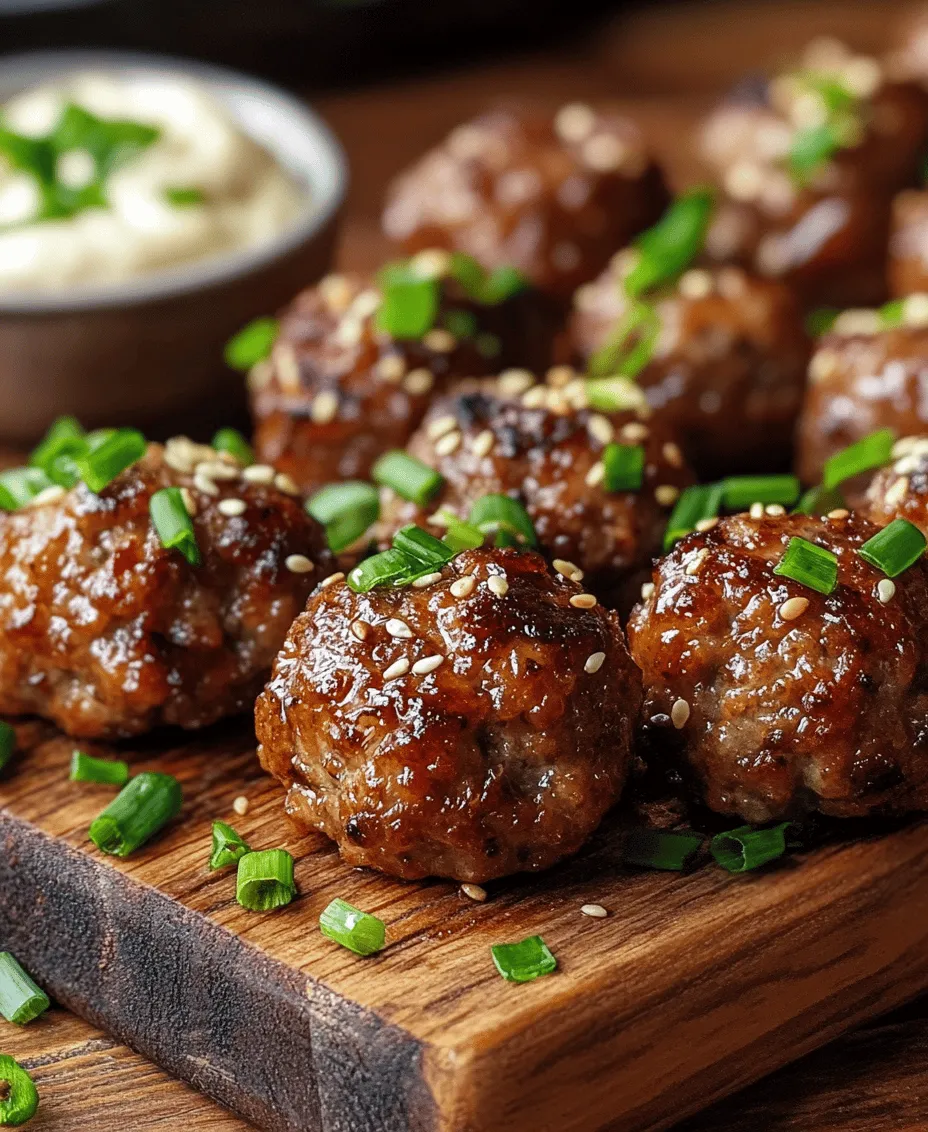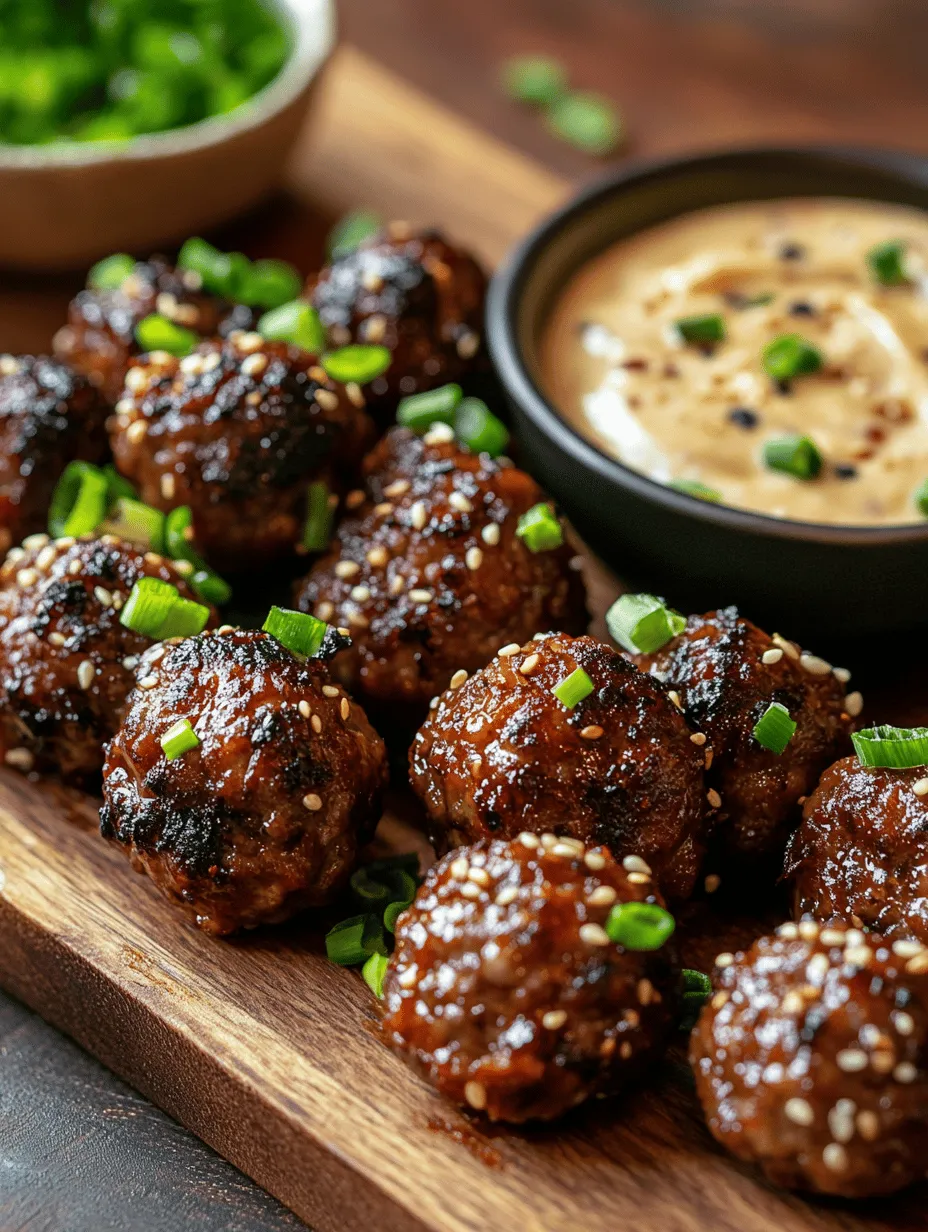Introduction
Korean cuisine has taken the culinary world by storm, captivating taste buds with its bold flavors, unique ingredients, and vibrant presentations. From the sizzling sounds of street food vendors grilling spicy tteokbokki to the comforting warmth of a bowl of kimchi jjigae, each dish tells a story of its cultural roots. One dish that perfectly embodies the essence of Korean cooking is Korean BBQ meatballs. These delightful morsels stand out not only for their rich flavor but also for their versatility, making them ideal for any occasion, whether as a tasty appetizer at a gathering or as a satisfying main course for a family meal.
The allure of Korean BBQ meatballs lies in their unique flavor profile, which combines savory, sweet, and spicy notes. Infused with traditional Korean ingredients, these meatballs are a fusion of hearty textures and aromatic seasonings. Paired with a creamy spicy mayo dip, they become an irresistible treat that tantalizes the palate. The dip, with its hint of heat and rich creaminess, complements the meatballs perfectly, creating a harmonious balance that is sure to please both seasoned Korean food lovers and newcomers alike.
Understanding the Key Ingredients
Creating delectable Korean BBQ meatballs requires a careful selection of ingredients that contribute to their signature taste and texture. Here’s an overview of the main components that make up this mouthwatering dish:
Ground Beef or Pork
The foundation of any meatball is, of course, the meat itself. In this recipe, you can opt for ground beef, pork, or even a combination of both. Each choice brings its unique flavor and fat content, which directly influences the meatball’s texture and juiciness. Ground beef offers a robust flavor, while pork provides a subtly sweet undertone. Whichever option you choose, the meat should be fresh and of good quality to ensure the best results.
Panko Breadcrumbs
Panko breadcrumbs are a crucial ingredient in achieving the perfect meatball texture. Unlike traditional breadcrumbs, panko is made from coarsely ground bread, resulting in a light and airy consistency. This helps the meatballs retain moisture during cooking while providing a delightful crunch. The addition of panko not only improves the structure of the meatballs but also allows them to hold their shape without becoming dense or heavy.
Aromatics: Garlic, Ginger, and Green Onions
Aromatics play a pivotal role in Korean cooking, and this recipe is no exception. Fresh garlic and ginger lend a fragrant warmth to the meatball mixture, while green onions add a mild, onion-like flavor and vibrant color. These ingredients are integral to creating the signature taste of Korean BBQ meatballs, infusing each bite with a depth of flavor that is unmistakably Korean. When combined, they create a savory base that elevates the overall dish.
Soy Sauce and Sesame Oil
Soy sauce is another essential ingredient that not only adds saltiness but also contributes to the umami flavor profile that is characteristic of Korean cuisine. It enhances the richness of the meat and complements the other ingredients beautifully. Sesame oil, with its nutty aroma, rounds out the flavor, adding a subtle richness that is often found in traditional Korean dishes. A drizzle of this oil can transform a simple recipe into a delightful culinary experience.
Gochujang
No Korean dish would be complete without gochujang, a savory and spicy fermented chili paste that is a staple in Korean kitchens. The depth of flavor and heat it provides is unmatched, making it a key player in the spicy mayo dip as well. Gochujang not only adds spiciness but also contributes a sweet undertone, balancing the heat with a touch of sweetness that makes the dish irresistible. Its versatility allows it to be used in marinades, sauces, and dips, making it an essential ingredient in this recipe.
Step-by-Step Guide to Making Korean BBQ Meatballs
Now that we’ve explored the key ingredients that contribute to the deliciousness of Korean BBQ meatballs, let’s dive into the step-by-step process of preparing this delightful dish. Follow these detailed instructions to ensure your meatballs turn out perfectly every time.
Preparing the Meatball Mixture
1. Gather Your Ingredients: Start by assembling all your ingredients on a clean work surface. This will help streamline the process and ensure that you have everything you need within reach.
2. Mix the Meat: In a large mixing bowl, combine the ground beef or pork with the panko breadcrumbs. Use your hands (make sure they’re clean) to gently mix the meat and breadcrumbs together. The key here is to avoid overmixing, as this can lead to tough meatballs. You want the mixture to be just combined.
3. Add Aromatics and Seasonings: Next, incorporate the minced garlic, grated ginger, chopped green onions, soy sauce, and sesame oil into the meat mixture. Gently fold these ingredients into the meat, ensuring they are evenly distributed. At this stage, you can also add the gochujang for an extra kick of flavor. Taste the mixture to adjust the seasoning if needed.
4. Achieving the Right Consistency: The meatball mixture should be moist but firm enough to hold its shape. If it feels too dry, you can add a splash of water or an egg to help bind the ingredients together. Conversely, if it feels too wet, a bit more panko can help absorb excess moisture.
Shaping the Meatballs
5. Forming the Meatballs: Once the mixture is well combined, it’s time to shape your meatballs. Using your hands, scoop out a portion of the mixture (about 1 to 1.5 inches in diameter) and roll it into a ball. Ensure that the meatballs are uniform in size for even cooking. You can use a cookie scoop for consistent portions if you prefer.
6. Spacing the Meatballs: As you shape the meatballs, place them on a baking sheet lined with parchment paper or lightly greased. Make sure to leave space between each meatball to allow for even cooking and to prevent them from sticking together.
Baking Process
7. Preheat the Oven: Before baking, preheat your oven to 400°F (200°C). This temperature ensures that the meatballs cook through while achieving a nice golden-brown color on the outside.
8. Baking the Meatballs: Once your oven is preheated, place the baking sheet with the meatballs in the oven. Bake for approximately 20-25 minutes, or until the meatballs are cooked through and have a nice golden exterior.
Key Indicators for Doneness
9. Checking for Doneness: To ensure your meatballs are fully cooked, check their internal temperature using a meat thermometer. The meatballs should reach an internal temperature of 160°F (71°C) for ground beef or 165°F (74°C) for ground pork. Additionally, look for a firm texture and a slightly browned exterior as indicators that they are ready to be enjoyed.
With these steps, you are well on your way to creating delicious Korean BBQ meatballs that will impress your guests and satisfy your cravings. In the next section, we will explore how to craft the perfect spicy mayo dip that will elevate your meatballs and take your culinary experience to the next level. Stay tuned for the creamy, spicy goodness that awaits!

Ingredients Breakdown for the Spicy Mayo Dip
To complement our delectable Korean BBQ meatballs, we will prepare a creamy and zesty spicy mayo dip. This dip not only enhances the flavor profile of the meatballs but also introduces a delightful creamy texture that balances the bold flavors of the dish. Here’s what you’ll need to create this delicious dip:
– Mayonnaise (1 cup): The base of our dip, providing creaminess.
– Sriracha Sauce (2-4 tablespoons): This will add heat and a touch of sweetness.
– Rice Vinegar (1 tablespoon): For acidity, to cut through the richness of the mayo.
– Sesame Oil (1 teaspoon): A small amount adds a nutty flavor that complements the Korean BBQ theme.
– Soy Sauce (1 teaspoon): Enhances umami flavor and adds depth.
– Honey or Sugar (1 teaspoon): Adjusts the sweetness, balancing the heat from the Sriracha.
– Green Onions (finely chopped, for garnish): Adds freshness and a pop of color.
Balancing Flavors: Sweetness, Spiciness, and Acidity
Achieving the perfect balance in the spicy mayo dip is crucial. The interplay of sweet, spicy, and acidic flavors will elevate your Korean BBQ meatballs to the next level.
– Sweetness: The honey or sugar counteracts the heat of the Sriracha, ensuring the dip isn’t overwhelmingly spicy. Adjust this component based on your preference; if you enjoy a more pronounced sweetness, feel free to add a bit more honey.
– Spiciness: The Sriracha is the star here. Start with two tablespoons for a mild kick, and increase it to four tablespoons if you enjoy a spicier dip. Remember, the heat will be more intense when the dip sits for a while, so consider your audience’s heat tolerance.
– Acidity: The rice vinegar provides a necessary tang that cuts through the creaminess of the mayo. This balance is essential to keep the dip light and refreshing rather than heavy.
Step-by-Step Instructions for Whisking the Dip
Creating the spicy mayo dip is a straightforward process that can be completed in just a few minutes. Here’s how to do it:
1. Combine Ingredients: In a medium mixing bowl, add 1 cup of mayonnaise, 2 tablespoons of Sriracha, 1 tablespoon of rice vinegar, 1 teaspoon of sesame oil, 1 teaspoon of soy sauce, and 1 teaspoon of honey.
2. Whisk Together: Using a whisk or fork, blend all the ingredients together until smooth and well combined. Ensure there are no lumps and the Sriracha is evenly distributed.
3. Taste and Adjust: This is a crucial step. Taste your dip and adjust the flavors to your liking. If it’s too spicy, add more mayonnaise or honey. If it needs more heat, add additional Sriracha.
4. Garnish: Once the desired flavor is achieved, transfer the dip to a serving bowl and garnish with finely chopped green onions. This adds a touch of color and freshness.
5. Chill: For the best flavor, allow the dip to chill in the refrigerator for at least 30 minutes before serving. This resting time helps the flavors meld beautifully.
Suggestions for Adjusting Heat Levels Based on Personal Preference
When it comes to spice, everyone has different tolerances. Here are a few suggestions for adjusting the heat level of your spicy mayo dip:
– Milder Version: Reduce the Sriracha to one tablespoon, or substitute it with a milder chili sauce like sweet chili sauce, which still provides flavor without overwhelming heat.
– Extra Spicy: For those who crave heat, consider adding a pinch of cayenne pepper or a few drops of hot sauce in addition to the Sriracha.
– Flavor Additions: You can also incorporate other flavoring agents such as garlic powder or lime juice for additional depth without necessarily increasing the heat.
Serving Suggestions and Pairings
Once your Korean BBQ meatballs and spicy mayo dip are ready, it’s time to think about presentation and pairings. Here are some creative ideas for serving:
– Presentation Ideas: Serve the meatballs on a large platter, garnished with sesame seeds and chopped green onions for visual appeal. Use small bowls for the spicy mayo dip, and consider adding pickled vegetables or kimchi on the side for an authentic Korean touch.
– Recommended Side Dishes: Pair your meatballs with steamed jasmine rice or cauliflower rice for a low-carb option. You could also serve them with a refreshing cucumber salad dressed in rice vinegar and sesame oil to complement the flavors.
– Beverage Pairings: For beverages, consider serving Korean rice wine (Makgeolli) or a light lager that can balance the heat and richness of the meatballs. Non-alcoholic options like iced green tea or a fruity lemonade can also be refreshing.
Variations: Using Different Proteins or Adding Vegetables
The beauty of Korean BBQ meatballs lies in their versatility. You can experiment with different proteins or even add vegetables to suit your taste:
– Protein Variations: While ground beef is a classic choice, you can also use ground pork, chicken, or turkey for a leaner option. For a vegetarian alternative, try using lentils or a mixture of finely chopped mushrooms and beans.
– Adding Vegetables: Incorporating grated carrots or finely chopped bell peppers into the meatball mixture can enhance texture and nutrients. You could also serve grilled vegetables alongside the meatballs for a more colorful platter.
Nutritional Information
Understanding the nutritional profile of the Korean BBQ meatballs and spicy mayo dip can help you make informed choices:
– Calories: Each serving of meatballs (approximately 4 meatballs) contains about 300 calories, depending on the protein used and serving size.
– Macronutrients: On average, the meatballs provide about 20g of protein, 15g of fat, and 20g of carbohydrates. The spicy mayo dip adds additional calories, roughly 100-150 calories per serving.
– Health Benefits: Using lean meats, such as ground chicken or turkey, can significantly reduce fat content while still providing high protein. The addition of fresh vegetables not only boosts flavor but also increases fiber intake.
Tips for Making the Recipe Healthier Without Sacrificing Flavor
If you’re looking to enjoy this delicious dish while keeping it healthy, here are some tips:
– Lean Meats: Opt for lean ground meats like turkey or chicken instead of higher-fat beef options.
– Whole Grain Options: Serve the meatballs with whole grain rice or whole wheat buns if making sliders.
– Vegetable Add-Ins: Incorporate grated zucchini or carrots into the meatball mixture for added moisture and nutrition without compromising flavor.
Cultural Significance of Korean BBQ
Korean BBQ has deep cultural roots, often seen as more than just a meal but an experience. It is a communal dining style where friends and family gather around a grill, cooking together, and sharing various side dishes known as banchan. This approach to dining fosters connection and celebration.
– History: Traditionally, Korean BBQ dates back to the Goguryeo era (37 BC – 668 AD), where grilled meat was enjoyed. Over centuries, it has evolved into the vibrant culinary tradition we see today, characterized by marinated meats, diverse side dishes, and lively social gatherings.
– Communal Aspects: The act of grilling meat at the table promotes interaction among diners, making it a festive occasion. Sharing food embodies the essence of Korean hospitality, where providing for guests is a high value.
– Modern Adaptations: Dishes like Korean BBQ meatballs reflect a blend of traditional flavors with modern cooking methods. It’s a great way to enjoy the rich history of Korean cuisine in a more accessible format.
Conclusion
Korean BBQ meatballs with spicy mayo dip not only bring exciting flavors to your table but also embody the communal spirit of Korean dining. Whether you are hosting a gathering or enjoying a cozy family dinner, this recipe offers versatility and the opportunity to experiment with various flavors and ingredients.
The ease of preparation and the ability to customize the recipe according to personal preferences make it a must-try for any culinary enthusiast. Enjoy the process of making these delightful meatballs, and don’t hesitate to share your creations with friends and family. Cooking is about exploration, so embrace the flavors and enjoy the delicious journey that is Korean BBQ.

